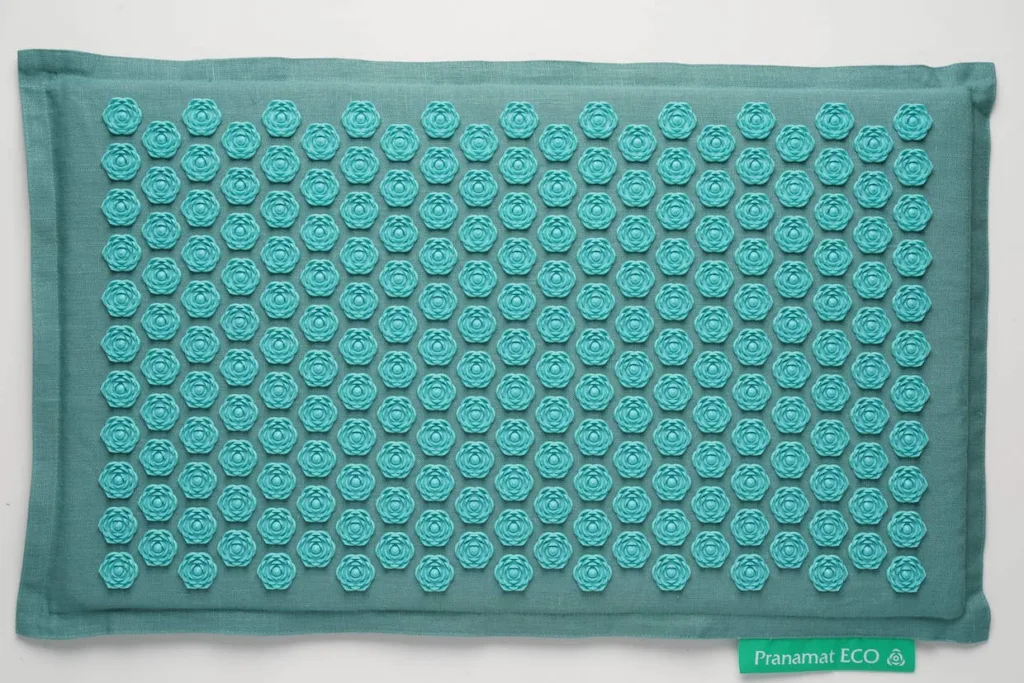As an acupressure specialist who personally experienced chronic lower back spasms, I know the journey isn’t easy. Determined to find the cause of back spasms and relieve the pain, I explored strengthening exercises and muscle relaxants. But the real breakthrough came when I discovered acupressure mats.
If you’re dealing with back spasms or low back pain, I urge you to see a doctor. But in this article, I will share my experience and tips on using acupressure mats to alleviate back spasms, highlighting their benefits in the journey towards a healthier back.
Fast Back Spasm Relief
Back spasms can be very painful and uncomfortable, but there are several ways to relieve the pain and discomfort:
- Heat or Ice: Apply to the affected area as you feel comfortable.
- Heating Pads: Use on a low or medium setting for 15-20 minutes every 2-3 hours.
- Over-the-counter Pain Relievers: Aleve, Advil, or Tylenol can ease the discomfort.
- Muscle Relaxants: These can be prescribed for severe spasms but should typically only be used for up to 72 hours.
- Stretching: Crucial for reducing muscle tension and potentially preventing muscle spasms.
- Good Posture & Exercise: Maintain an upright posture and regularly stretch after every 30 minutes of sitting.
- Acupressure Mats: Just 15 minutes daily can stimulate your muscles and help reduce pain and tension.
Remember to consult a healthcare provider if your back spasms persist or worsen.
However, if the back spasms persist or worsen, it’s crucial to consult a healthcare provider for accurate diagnosis and treatment. Your wellbeing is paramount.
Understanding Back Spasms
Before we dive into how acupressure mats can help, let’s delve into understanding back spasms better. They are involuntary contractions or cramps occurring in your back muscles. They can happen anywhere from your neck to your lower back, with the latter being more common due to weight-bearing.
Causes of Back Spasms
Several factors can trigger these painful contractions:
- Poor posture
- Physical injury or strain
- Underlying health issues like herniated discs or spinal stenosis
- High levels of stress and tension
Identifying Back Spasms
The symptoms of back spasms can vary, but here are the most common ones:
- Sudden, sharp pain in the back
- Stiffness or tightness in the back muscles
- Difficulty moving or bending
- Pain localized in the lower back
- Pain radiating down the legs or arms
If you’re experiencing persistent severe spasms, it’s crucial to consult a healthcare professional.
Navigating the Medical Maze
If you’re experiencing persistent, severe back spasms, don’t hesitate to consult a healthcare professional. They can evaluate your symptoms, conduct physical exams, and order tests like X-rays, MRIs, or CT scans to identify underlying conditions.
Now that we’ve covered the basics, let’s move on to the exciting part: how I found relief from back spasms with the help of acupressure mats!
The Power of Acupressure Mats
Acupressure mats are a fantastic tool that combines modern design with ancient wisdom. Covered in tiny spikes, these mats help stimulate the body’s pressure points, a concept rooted in traditional Chinese medicine.

When pressed against your back, these spikes increase blood flow to the area and stimulate the release of endorphins, your body’s natural painkillers. Sounds interesting, right? But how does this play out in real life?
My Personal Journey to Back Spasm Relief with Acupressure Mats
Initially, I was skeptical. The idea of lying down on a mat covered in spikes seemed counterintuitive. However, as I began to use it regularly, I experienced significant changes.

The immediate effect was a reduction in the intensity of my spasms, and with regular use, I noticed my back becoming stronger and more resilient. Moreover, my clients, too have reported significant improvements in their conditions, affirming the effectiveness of acupressure mats.
The Power of Acupressure
Acupressure, a sister concern of acupuncture, has been around for centuries. Its origins can be traced back to ancient China. Acupressure involves using pressure on specific body points to relieve pain, promote relaxation, and improve overall well-being. The pressure is applied using fingers, hands, elbows, or other devices, such as acupressure balls or mats.
Like acupuncture, acupressure is based on the principles of traditional Chinese medicine, which holds that energy flows through the body along pathways called “meridians.” Acupressure practitioners aim to balance the body’s energy flow and promote healing by applying pressure to specific points along these meridians.

Research has shown that acupressure can effectively relieve various conditions, including headaches, back pain, menstrual cramps, and nausea. It is also used to promote relaxation and reduce stress.
Acupressure can be performed by trained practitioners or learned and practiced at home. However, as with any alternative therapy, it is important to consult a healthcare provider before starting acupressure, especially if you have any underlying health conditions.
Acupressure Mats and How They Work
So, what do acupressure mats have to do with all of this? Well, these mats are based on the same principle. They’re filled with thousands of tiny spikes that apply pressure to various points on your body.
The Science Behind Acupressure Mats
The spikes stimulate blood flow and release endorphins, your body’s natural painkillers. So, you’re getting a natural high while relieving pain!
My Personal Experience with Back Spasms
Let me tell you, back spasms are no walk in the park. The pain can be excruciating and debilitating.
The Pain of My Back Spasms
It’s like having a tiny goblin repeatedly stabbing you in the back. Not a pleasant experience, I assure you. Despite trying out numerous remedies, the spasms persisted.
Trying Out Acupressure Mats

I was skeptical the first time I laid eyes on an acupressure mat. The little spikes looked more menacing than relieving.
The First Experience
But, you know what they say – don’t judge a book by its cover (or in this case, a mat by its spikes).
Adjusting to the Mat
After a few uncomfortable minutes, something amazing happened. The pain started to fade away!
How Acupressure Mats Provided Relief
It was like a symphony of relief washed over me. But the magic of the acupressure mat didn’t stop there.
Immediate Effects
The immediate effect was a noticeable reduction in the intensity of my back spasms. I felt relaxed, like a giant weight had been lifted off my shoulders.
Long Term Effects
Over time, I also noticed that the frequency of the spasms reduced significantly.
Strengthening Your Back with Acupressure Mats
One of the best things about these mats is their ability to help strengthen your back.
Integrating it into Your Routine
It was as simple as lying on the mat for about 20 minutes daily. Easy-peasy, lemon squeezy!
Tips for Best Use of Acupressure Mats
Using an acupressure mat can seem a bit daunting initially. Here are some tips to get you started:
- Start Slow: Initially, use the mat for short periods (around 10 minutes) and gradually increase the time.
- Use a Thin Cloth: If the pressure is too intense, use a thin cloth as a barrier between you and the mat.
- Listen to Your Body: If you feel any discomfort or pain, stop using the mat and consult with a healthcare professional.

Who Shouldn’t Use Acupressure Mats?
Those with skin conditions, pregnant women, and individuals with certain medical conditions should consult a doctor before use.
Ensuring a Strong, Spasm-Free Back
Strengthening your back muscles can significantly reduce the chances of back spasms. Regular exercises that target your back, like deadlifts, rows, lat pulldowns, and supermans, can go a long way in keeping your back strong. Incorporating activities like yoga, Pilates, walking, swimming, or biking into your daily routine can also contribute to a healthier, stronger back.
Don’t Ignore These Symptoms!
While acupressure mats are a fantastic tool for back spasm relief, please do not ignore any severe symptoms. If you experience persistent back pain, unexplained weight loss, fever, numbness or tingling in the limbs, or loss of bladder or bowel control, seek immediate medical attention.
Conclusion: Embrace the Relief of Acupressure Mats
Dealing with muscle spasms, particularly in the lower back, can lead to a painful, life-altering journey. These spasms may cause distressing pain in your back muscles, leaving you searching for effective home treatment for your chronic low back pain. However, there’s good news – introducing acupressure mats into your daily routine could be a promising strategy to relieve pain and prevent back spasms.
Lower back spasms can make even the most basic back movements challenging, reducing your quality of life. But the right treatment options, like daily exercises and stretches, can offer immediate relief and prevent spasms from recurring. Chronic spasms, acute back pain, and back spasm symptoms shouldn’t define your life.
As someone who used to experience back spasms, I can vouch for the effectiveness of acupressure mats. They offer a potent combination of relief and prevention, helping to strengthen your back and abdominal muscles, support your back, and reduce the risk of back injury.
So, don’t let the fear of painful spasms or weak back muscles hold you back. Embrace acupressure mats – they can provide relief, prevent muscle spasms, and trigger back spasms to fade. Remember, a good back today can lead to a pain-free tomorrow.
FAQs about causes and preventing back spasms
Q: What are back spasms?
A: Back spasms are sudden contractions or tightening of the muscles in the lower back.
Q: What causes back spasms?
A: Back spasms can be caused by various factors, including muscle strain or injury, poor posture, dehydration, and even stress.
Q: What are some symptoms of back spasms?
A: Symptoms of back spasms may include sudden pain and tightness in your lower back muscles, difficulty moving or standing up straight, and muscle weakness.
Q: Are back spasms serious?
A: Back spasms can be painful and make it difficult to perform daily activities, but they are usually not serious and can be managed with proper treatment.
Q: How do I diagnose back spasms?
A: If you experience sudden back pain and muscle spasms that last for a few days, you should see a doctor to diagnose the cause of your symptoms.
Q: What are some treatments for lower back spasms?
A: Treatment for lower back spasms may include rest, ice or heat therapy, over-the-counter pain medication, stretching exercises, and physical therapy.
Q: How can I prevent lower back spasms?
A: Preventing lower back spasms can be done by maintaining proper posture, staying hydrated, avoiding heavy lifting, and doing regular exercise to strengthen your lower back muscles.
Q: How do I relieve back spasms?
A: Relief for back spasms may include taking over-the-counter pain medication, applying heat or ice to the affected area, and doing gentle stretches or exercises to loosen the muscles.
Q: Can muscle relaxants help relieve back spasms?
A: In some cases, your doctor may prescribe muscle relaxants to help relieve spasm pain and reduce muscle tension in your back.
Q: When should I see a doctor for back spasms?
A: You should see a doctor if you experience severe or persistent back pain and muscle spasms, especially if other symptoms like fever or difficulty urinating accompany them.

